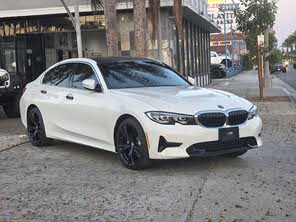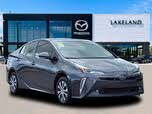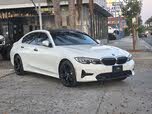2020 Toyota Prius vs 2019 BMW 3 Series
Overview | |
MSRP$40,250 | MSRP$24,325 |
Listings359 | Listings108 |
Ratings & Reviews | |
User Reviews | User Reviews |
Expert reviews8.2 out of 10 | Expert reviews7.5 out of 10 |
Pros
Cons
| |
2019 BMW 3 Series Reviews SummarySince 1975, the BMW 3 Series has defined what a small, sporty sedan should be. In its seventh generation, the 3 is very much in the zone it created. It’s trim and athletic, handsome yet stoic, and above all, unashamed to raise its premium name on a pedestal. Unfortunately for BMW, lots of other car companies have copied its sport sedan recipe—sometimes for the better, and often for less money. But for 2019, BMW ups its software game like none other. And it helps that the new car surrounding that software is still pretty good. | |
2020 Toyota Prius Reviews SummaryEver heard of an eponym? It’s a brand or product that is so popular that it’s come to define its respective market. Think of Kleenex for tissues or Band-Aid for medical bandages. For hybrids, the Toyota Prius has ascended to near-eponym status. It was one of the first—and remains one of the most popular—hybrids ever made. As automakers across the industry are rolling out more hybrid models, the Prius continues to be the standard-bearer of this genre. This is largely due to the fact that the Prius is a dedicated hybrid, rather than a hybrid variant of an existing model. Throughout the industry, different companies are taking different approaches to alt-fuel vehicles, including full-electric and hydrogen fuel cell powertrains. The Prius endures as the leader in hybrid power due to a focus on fuel efficiency that doesn’t compromise on style, drivability, and versatility. So how does the Prius hold its ground as more players enter the fray? Read on to find out. | |
No video found | |
Popular Features & Specs | |
Engine2.0L 255 hp I4 | Engine1.8L 121 hp I4 Hybrid |
Drive TrainRWD | Drive TrainFWD |
Seating Capacity5 | Seating Capacity5 |
Horsepower255 hp @ 5000 rpm | Horsepower |
EV Battery Capacity | EV Battery Capacity0.7 kWh |
MPG City26 | MPG City58 |
MPG Highway36 | MPG Highway53 |
Engine | |
Engine Name2.0L 255 hp I4 | Engine Name1.8L 121 hp I4 Hybrid |
Torque295 lb-ft @ 1450 rpm | Torque |
Horsepower255 hp @ 5000 rpm | Horsepower |
DrivetrainRWD | DrivetrainFWD |
Fuel Economy | |
EV Battery Capacity | EV Battery Capacity0.7 kWh |
MPG City26 | MPG City58 |
MPG Highway36 | MPG Highway53 |
Interior | |
Seating Capacity5 | Seating Capacity5 |
Key Features | |
Sunroof/MoonroofStandard | Sunroof/Moonroof |
Safety | |
Front Crash Overall | Front Crash Overall4 |
Side Crash Overall | Side Crash Overall5 |
Dimensions & Capacity | |
Cargo Space13.0 cu ft | Cargo Space27.4 cu ft |
Curb Weight3589 lbs | Curb Weight3010 lbs |
Height56.8 in | Height57.9 in |
Length185.7 in | Length180.0 in |
Width81.4 in | Width69.3 in |
Wheelbase112.2 in | Wheelbase106.3 in |
Maximum Payload | Maximum Payload825 lbs |
Number of doors4 | Number of doors4 |
Overview | ||
MSRP | $40,250 | $24,325 |
Listings | ||
Ratings & Reviews | ||
User reviews | ||
Expert reviews | 8.2 out of 10Read full review | 7.5 out of 10Read full review |
Pros & cons | Pros
Cons
| |
Summary | Since 1975, the BMW 3 Series has defined what a small, sporty sedan should be. In its seventh generation, the 3 is very much in the zone it created. It’s trim and athletic, handsome yet stoic, and above all, unashamed to raise its premium name on a pedestal. Unfortunately for BMW, lots of other car companies have copied its sport sedan recipe—sometimes for the better, and often for less money. But for 2019, BMW ups its software game like none other. And it helps that the new car surrounding that software is still pretty good. | Ever heard of an eponym? It’s a brand or product that is so popular that it’s come to define its respective market. Think of Kleenex for tissues or Band-Aid for medical bandages. For hybrids, the Toyota Prius has ascended to near-eponym status. It was one of the first—and remains one of the most popular—hybrids ever made. As automakers across the industry are rolling out more hybrid models, the Prius continues to be the standard-bearer of this genre. This is largely due to the fact that the Prius is a dedicated hybrid, rather than a hybrid variant of an existing model. Throughout the industry, different companies are taking different approaches to alt-fuel vehicles, including full-electric and hydrogen fuel cell powertrains. The Prius endures as the leader in hybrid power due to a focus on fuel efficiency that doesn’t compromise on style, drivability, and versatility. So how does the Prius hold its ground as more players enter the fray? Read on to find out. |
Video | No video found | |
Popular Features & Specs | ||
Engine | 2.0L 255 hp I4 | 1.8L 121 hp I4 Hybrid |
Drive Train | RWD | FWD |
Seating Capacity | 5 | 5 |
Horsepower | 255 hp @ 5000 rpm | |
EV Battery Capacity | 0.7 kWh | |
MPG City | 26 | 58 |
MPG Highway | 36 | 53 |
Engine | ||
Engine Name | 2.0L 255 hp I4 | 1.8L 121 hp I4 Hybrid |
Torque | 295 lb-ft @ 1450 rpm | |
Horsepower | 255 hp @ 5000 rpm | |
Drivetrain | RWD | FWD |
Fuel Economy | ||
EV Battery Capacity | 0.7 kWh | |
MPG City | 26 | 58 |
MPG Highway | 36 | 53 |
Interior | ||
Seating Capacity | 5 | 5 |
Key Features | ||
Sunroof/Moonroof | Standard | |
Safety | ||
Front Crash Overall | 4 | |
Side Crash Overall | 5 | |
Dimensions & Capacity | ||
Cargo Space | 13.0 cu ft | 27.4 cu ft |
Curb Weight | 3589 lbs | 3010 lbs |
Height | 56.8 in | 57.9 in |
Length | 185.7 in | 180.0 in |
Width | 81.4 in | 69.3 in |
Wheelbase | 112.2 in | 106.3 in |
Maximum Payload | 825 lbs | |
Number of doors | 4 | 4 |
The 2019 BMW 3 Series maintained BMW's evolutionary design approach, avoiding major transformations seen in competitors like Mercedes-Benz and Lexus. The car's compact footprint made it easy to park and maneuver, while subtle design changes, such as the sliced-off Hoffmeister kink on the rear doors, added a modern touch. The front retained the recognizable BMW look with hard-edged half-circle LED running lamps and widened kidney grilles. The tail featured simplified LED lights, though some felt it resembled the new Kia Forte. Inside, the 3 Series kept its driver-focused layout with a digital instrument panel and optional wireless charging pad. However, some materials felt coarse compared to previous models.
The 2020 Toyota Prius continued its iconic jellybean-like shape, optimized for aerodynamics. Toyota made visual tweaks to give it a more sedan-like appearance while retaining its hatchback functionality. The Prius's futuristic style remained contemporary, with a central location for instrumentation and gauges. Trim levels ranged from the entry-level L Eco to the range-topping Limited, each adding more features like synthetic leather upholstery, heated seats, and a large 11.6-inch touchscreen. The 2020 Edition celebrated 20 years of the Prius with unique dark exterior accents and a limited production run.

















The 2019 BMW 3 Series, particularly the 330i xDrive, showcased BMW's engine expertise with a 2.0-liter turbocharged inline-4 delivering 255 horsepower and 295 pound-feet of torque. The M340i variant offered a twin-turbo 6-cylinder engine with 382 hp and 369 lb-ft, nearing M3 performance levels. The 8-speed automatic transmission provided perfect shifts, and the M Sport package enhanced handling with a firmer suspension and variable-ratio steering. Fuel economy for the 330i xDrive was EPA-rated at 25 mpg city, 34 highway, and 28 combined.
The 2020 Toyota Prius featured a 1.8-liter four-cylinder engine paired with an electric motor, producing a combined 121 horsepower and 105 pound-feet of torque. The Prius AWD-e variant added a second electric motor for the rear wheels, operating up to 43 mph. The Prius offered smooth acceleration and seamless transitions between electric and conventional power. It had three drive modes—EV, Eco, and Power—each catering to different driving needs. The unique shifter design and Engine Braking mode added to its distinctiveness. The Prius's low center of gravity provided sharper handling than expected, making it ideal for commuting.
The 2019 BMW 3 Series offered a spacious interior with increased backseat legroom and 17 cubic feet of trunk space. The seats were firm yet supportive, and visibility was good in all directions. The infotainment system, head-up display, and instrument clusters were intuitive and easy to operate. The main screen was now a touchscreen, supporting various gestures, and the climate controls included a third zone for rear passengers. USB-C ports were also available.
The 2020 Toyota Prius made excellent use of its compact platform, with deep door pockets and a large tray area between the front seats. The front seats provided ample headroom and legroom, and driver visibility was good. The rear seats were spacious, though taller passengers needed to be cautious. The Prius offered 50.7 cubic feet of cargo space with the rear seats folded and up to 27.4 cubic feet with the seats up, making it one of the most versatile hybrid vehicles. The hatchback design facilitated easy loading of large items.
The 2019 BMW 3 Series featured extensive technology, though many functions required subscription fees. The iDrive system was customizable and updated over the air. The navigation system learned driving patterns and adjusted for traffic. Gesture control and a personal assistant added convenience, though they were sometimes unreliable. The BMW Connected App allowed remote start, and the Driving Assistance Professional Package offered advanced safety features like automatic steering around curves.
The 2020 Toyota Prius came standard with a 7-inch touchscreen, Android Auto, Apple CarPlay, Bluetooth connectivity, a WiFi hotspot, and three USB ports. The Limited trim upgraded to an 11.6-inch screen with a customizable layout, though it lacked Android Auto. The top-center instrument panel displayed hybrid drivetrain status and other critical readouts. The available head-up display (HUD) provided additional convenience.
The 2019 BMW 3 Series earned a Top Safety Pick+ rating from the IIHS, with top ratings in all six crash tests and high marks for its optional laser headlights and standard forward emergency braking. Pedestrian detection, blind-spot monitoring, 360-degree cameras, adaptive cruise control, lane-keeping assist, and Traffic Jam Assist were available.
The 2020 Toyota Prius came with Toyota Safety Sense 2.0, including automatic emergency braking, forward-collision warning, lane-departure warning, adaptive cruise control, and automatic high beams. Optional features included blind-spot monitoring, rear cross-traffic alert, parking sensors, and lane-tracing assist. The Prius earned a five-star rating from the NHTSA and a Top Safety Pick rating from the IIHS, though it fell short of the highest rating due to average scores in some tests.
CarGurus highlights

According to CarGurus experts, the overall rating for the 2019 BMW 3 Series is 8.2 out of 10, while the 2020 Toyota Prius scores 7.5 out of 10. Based on these ratings, the 2019 BMW 3 Series is the recommended choice for its superior performance, advanced technology, and luxury features.
Choose the 2020 Toyota Prius if:
- You need a highly efficient hybrid with excellent fuel economy.
- You require versatile cargo space and a practical hatchback design.
- You want comprehensive standard safety features and high safety ratings.
Choose the 2019 BMW 3 Series if:
- You prioritize performance and handling with powerful engine options.
- You value advanced technology and customizable infotainment.
- You seek a luxury sedan with top safety ratings and features.
CarGurus highlights

According to CarGurus experts, the overall rating for the 2019 BMW 3 Series is 8.2 out of 10, while the 2020 Toyota Prius scores 7.5 out of 10. Based on these ratings, the 2019 BMW 3 Series is the recommended choice for its superior performance, advanced technology, and luxury features.
Choose the 2020 Toyota Prius if:
Shop Now- You need a highly efficient hybrid with excellent fuel economy.
- You require versatile cargo space and a practical hatchback design.
- You want comprehensive standard safety features and high safety ratings.
Choose the 2019 BMW 3 Series if:
Shop Now- You prioritize performance and handling with powerful engine options.
- You value advanced technology and customizable infotainment.
- You seek a luxury sedan with top safety ratings and features.

By: CarGurus + AI
At CarGurus, our team of experienced automotive writers remain at the heart of our content operation, conducting hands-on car tests and writing insightful guides that are backed by years of industry experience. To complement this, we are harnessing AI to make our content offering more diverse and more helpful to shoppers than ever. To achieve this, our AI systems are based exclusively on CarGurus content, ratings and data, so that what we produce is both unique to CarGurus, and uniquely helpful to car shoppers.








































